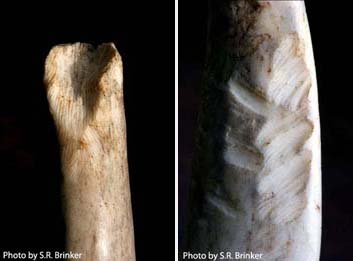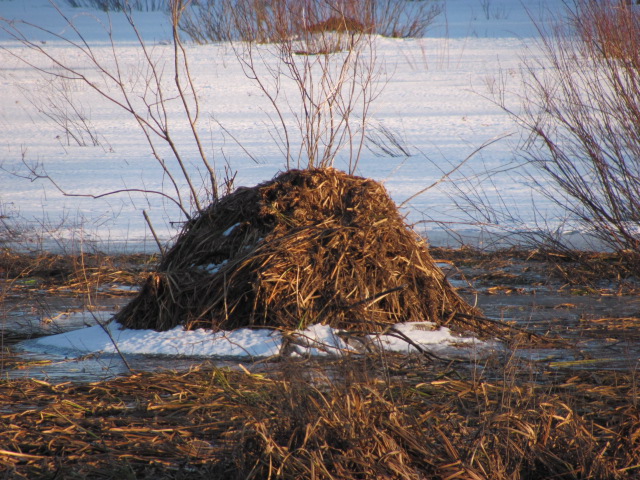Search for Resources
Muskrats Make the Most of Life Under the Ice
Early-Mid January 2024Top R4R Picks
Resources for extending the learning
-
Providing a Backyard Feeding Station for BirdsMiddle, Secondary
-
Winter StormsElementary, Middle, Secondary
-
Alien Invaders: Threats to BiodiversityElementary, Middle
-
-
-
Rick Mercer: Black Bear Tagging in Algonquin ParkMiddle, Secondary
-
Hurrah for Muskrats!Elementary, Middle
-
Sizing Up WinterElementary
-
Alien Invaders: Species that threaten our worldElementary, Middle
-
Muskrat Will Be SwimmingElementary, Middle
-
Owl MoonElementary
Featured Species: Muskrat ramble, part 2
Muskrats were featured in mid-November, and a brief mention was made of push-ups and feeding huts. From now until ice-out, these features will be prominent in local marshes, as Muskrats continue to ramble beneath the ice and snow.
Muskrats out on the ice are pretty exposed, so they create pushups . To form a pushup, Muskrats chew a small (10 – 15 cm) hole in the thin, newly-forming ice, and “push up” a pile of vegetation less than a half-metre high. This wet vegetation freezes, and forms a hard little dome for the muskrat to breathe and rest in safe from predators. In Alaska, Blackfish will also use the holes to get oxygen, and their activity helps the Muskrat maintain an open hole. Yes, everything is connected.
To confuse matters a bit, Muskrats also build feeding huts in the winter, which are mid-way in size between a lodge and a pushup, and are used more for feeding than the pushup is, since there is more room. Unlike most lodges, both push-ups and feeding huts will collapse in the spring.
With this network in place Muskrats can stay busy all winter, following their trails under ice and chowing down on cattails.
INVASIVE ALERT!– Phragmites
Cattails are the Muskrat’s favourite food and a hardy plant that thrives in Canadian freshwater wetlands. However, the cattail is under threat from an invasive grass species that is an ecological bully! European Phragmites has been identified by Agriculture and Agri-Food Canada as Canada’s worst invasive plant! It aggressively crowds out native plants and releases toxins from its roots which affect the growth of other flora. You might think that a grass species like Phragmites must provide great cover and food for wildlife. Unfortunately, Phragmites stands are so dense that they provide very poor habitat and the plant has almost no nutritional value. Sometimes this species grows so thickly that it actually reduces water levels in the marsh which impacts wetland wildlife like fish, amphibians and even Muskrats. One of the more interesting aspects of the Phragmites invasion is that there is an American subspecies (scroll down) which is native and poses no threat. However, the tall European Phragmites plumes are hard to miss, especially in the winter when you might be out looking for wildlife signs like muskrat lodges. So enjoy a midwinter wetland trip and if you encounter Phragmites report your sighting to an invasive species hotline to help keep our wetlands safe from this hostile intruder! ![]()
Other Happenings:
- So far, no Great Gray Owl sightings have been reported in southeastern Canada but this beautiful boreal forest resident sometimes wanders south in winter seeking food. Keep an eye out for them. Snowy Owls are also regular winter visitors to southern regions of Ontario, Quebec and the western Prairies. So far, it's been a slow year for Snowies from the Great Lakes to the eastern coast, and few have been recorded in Christmas Bird Counts across Canada. Snowy Owls are also regular visitors to some U.S. states, where they are being tracked through Project Snowstorm . So with lots of winter remaining, keep your eyes open for migrant owls and other remarkable birds of prey like Golden and Bald Eagles as they cruise over frozen landscapes in search of a tasty meal!
- Black-capped Chickadees, Red-breasted Nuthatches, and White-breasted Nuthatches are active throughout the winter. Chickadees survive in part by significantly lowering their body temperature at night, and choosing good roost holes. They also stay dry with oil from their preen gland. Still, in very cold weather they may need to eat their weight (40 g) in food each day to survive. They eat lots of conifer and other seeds as well as insects that they find and have cached away. Chickadees will also snack on fat and bits of meat from dead animals opened up by larger predators and scavengers. Nuthatches will huddle together in hollows or nesting boxes. Look for survival signs of birds that stick it out through the winter. Observing Goldenrod galls (which we discussed in Mid-September) may provide just such survival signs. Goldenrod galls are very evident now, as much of the vegetation has died back. The Goldenrod Gall Fly makes its home in the gall for the winter, but eats a tunnel close to the surface before it goes dormant. You may find galls opened and the larva eaten by either Downy Woodpeckers or Black-capped Chickadees, adding to the food web that these insects support. Keep checking on these galls throughout the winter to see how many become a bird lunch. You might also see European Starlings, Mourning Doves, and Canada Geese out and about at this time of year.
- Beavers are mating - faithfully. They mate for life until one dies. Find active lodges by checking after a recent snow for steam rising, a depression or gap at the breathing hole near the top, where the animals’ heat has melted the snow.
- All month both male White-tailed Deer and Moose are shedding their antlers, which will be gnawed upon by small mammals for their calcium and other vital minerals.

- Early this month Black Bears give birth to two or three cubs, about the size of chipmunks and very cute - Rick Mercer certainly thought so!
- In Early December we talked about the molecular magic of snow, and with recent snow squalls and cold temperatures winter has certainly arrived. Have you ever wondered if relatives or friends are enjoying (or maybe I should say experiencing) snow elsewhere in the world? Check out this website to see current snow and ice cover around the world.
- As our orbit around the sun gives us seasons, we also get a different view of the stars. On top of that, the Earth’s spin provides slightly different views, as the locations of constellations appear to move over the course of a night sky. The best known constellation is the Big Dipper (Ursa Major), which is visible to us in the Northern Hemisphere year round since it is located above the horizon. The Big Dipper is low to the northeast now. Due to the Earth’s spin it will appear to rotate around the North Star (Polaris), which can be located by extending out (or up) from the two stars at the end on the big dipper’s bowl. There are lots of good reasons to star gaze. It can also be integrated with subjects such as history. Stellarium is a great, free teaching tool for bringing the night sky into the classroom. Nothing beats star gazing on a dark, clear winter night with hot chocolate though (here are some activity ideas)!
- The Earth was at it’s closest point to the sun at 8:00 p.m. EST January 2, about 5 million km closer than at its most distant point in July. Sounds like a lot, but its effect pales before the tilt of the earth, and so we can’t expect warmth anytime soon.
- The moon will have passed Venus and be close to Mercury to the SE on the morning of the 9th. Mercury will be at its greatest distance from the sun on the 15th. By the evening of the 13th, the moon will have swung around the sun and will be approaching Saturn to the SW. It passes by Jupiter between the 17th and the 18th. (scroll down)
- Sirius, the faithful Dog Star to Orion, will one day become the southern pole star. Just don’t plan to wait for it — it will take its place in 66270.


